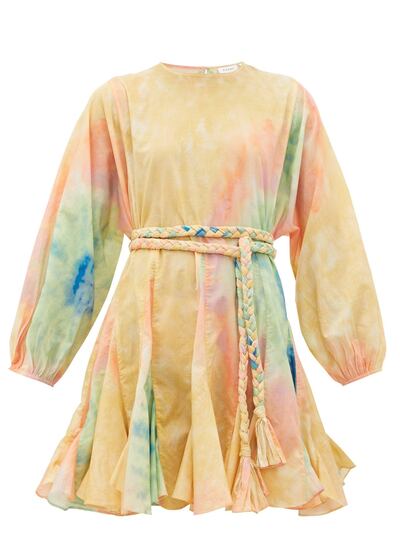Bored of making banana bread? Finished all the jigsaw puzzles? Taken your selfie wearing a belted pillow? If you are looking for your next lockdown pastime, well, here it is: home-made tie-dye.
With vast swaths of the planet either confined to their homes or cautiously emerging, it seems as if people are still looking for ways to keep entertained at home. No doubt inspired by the trend of this season, where tie-dye ruled the runways at Christian Dior, Stella McCartney and Prada, people are now feeling brave enough to copy this cheerful trend at home, if social media is any indication.
Of course, one of the great joys of tie-dye is that it is easy to do and anyone can have a go. By the very nature of the swirled patterns this technique creates, it is impossible to get it wrong.

What do you need?
A cotton T-shirt or top, a packet of fabric dye, some salt (to make the dye adhere to the fabric), some string and, most importantly, a sense of adventure.
How does it work?
By twisting the fabric and tying it, in effect you are blocking dye from reaching certain areas, and it is these ‘blank’ areas that creates the pattern. Those spaces can, of course, be filled in with another colour, or left white, whatever your personal preference. Depending on how the fabric is twisted, scrunched, folded and tied, different patterns will emerge and, best of all, each one is utterly, totally unique.
In Japan, the process is called shibori and produces complex patterns of white on indigo. In India, meanwhile, it is known as bandhani and is used to decorate entire shawls and turbans in tiny circles of rich shades of red.
How do you create it?
To do this at home, first find a cotton T-shirt or top (it must be cotton, this will not work on synthetic materials) and then start to twist, scrunch or pinch parts of the fabric, securing those areas with string.
Once ready, pour dye directly on to the cloth wherever and however you feel. Either use one colour for a two-tone effect, or splash on a few in different places for something even more vibrant.
Once finished, place the item inside a plastic bag to keep out the air. By nature, this process of dying has an element of unpredictability, which is half the fun. There is no knowing how it looks until it is unwrapped, so surrender to the process.
This YouTube video shows you what to do:
Wait at least eight hours, and then remove the garment from the bag, take off the string, and hand wash in warm water. If the dye used has a separate packet of ‘fixing’ solution, now is the time to add it.
Due to the messy mature of this process, it is best to do this in the bath, or use a large bucket with plastic sheeting underneath. Don’t do this on the kitchen table unless you want badly dyed wood and, given the current state of the world, there is no excuse not to wear gloves.
Once washed and dried, enjoy wearing your new top, secure in the knowledge that thought it may not have turned out how you expected it, beautiful or ugly, this is the only one like it in the world.






